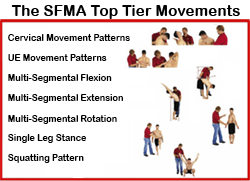
What is it?
Developed by a physical therapist, the Selective Functional Movement Assessment (SFMA) is a series of 7 full-body movement tests designed to assess fundamental patterns of movement such as bending and squatting in those with known musculoskeletal pain.) SFMA is a diagnostic system used to assess the quality of your movement. The primary focus of SFMA is not how many repetitions you can perform, but how well you can perform a single repetition. It's about how well you move.
Why this is important
When the clinical assessment is initiated from the perspective of the movement pattern, the clinician has the opportunity to identify meaningful impairments that may be seemingly unrelated to the main musculoskeletal complaint, but contribute to the associated disability. This concept, known as Regional Interdependence, is the hallmark of the SFMA. The SFMA looks at simple every day actions, including the ability to touch your toes, balance on one leg, or perform a squat, to identify how you accomplish basic movement. Poor movement in the body is often masked by compensations that we develop overtime and daily repetition of this can ultimately result in injury and pain. Functional restoration requires a map of dysfunctional patterns and a working knowledge of functional patterns to gain clinical perspective and design an effective treatment strategy.
How does it work?
The assessment guides the clinician to the most dysfunctional non-painful movement pattern, which is then assessed in detail. This approach is designed to complement the existing exam and serve as a model to efficiently integrate the concepts of posture, muscle balance and the fundamental patterns of movement into musculoskeletal practice. By addressing the most dysfunctional non-painful pattern, the application of targeted interventions (manual therapy and therapeutic exercise) is not adversely affected by pain. The SFMA enables the therapist to identify and treat regions in the body that lack mobility (range of motion), or stability (motor control), allowing for an accurate treatment to restore pain-free function and movement. The SMFA also highlights asymmetries in the body that exist between the left and right side. Asymmetries, such as having a left hip that moves well and a right hip that is stiff, are red flags and are significant risk factors for injury.
The SFMA pulls out these subconscious dysfunctional and/or asymmetrical movements to get to the root of the problem. Efficiency in movement is the key to accomplishing your goals. The essence of the SFMA is that the site of your pain may not be the source or cause of your pain. The pain in your knee may be the result of a problem in your hip. The pain in your neck may be the result of an issue in your shoulder. Treating the cause of your pain, and not merely the site, is vital to restoring pain-free movement and function.
At Sacramento Spine & Physical Therapy, we value the SFMA because it is a tool that allows us to build a plan based on the needs of each individual. Our focus on treating the underlying cause with hands on treatment and a thorough exercise program gets you moving pain-free and back into action. We want you feeling your best throughout all your daily activities.
